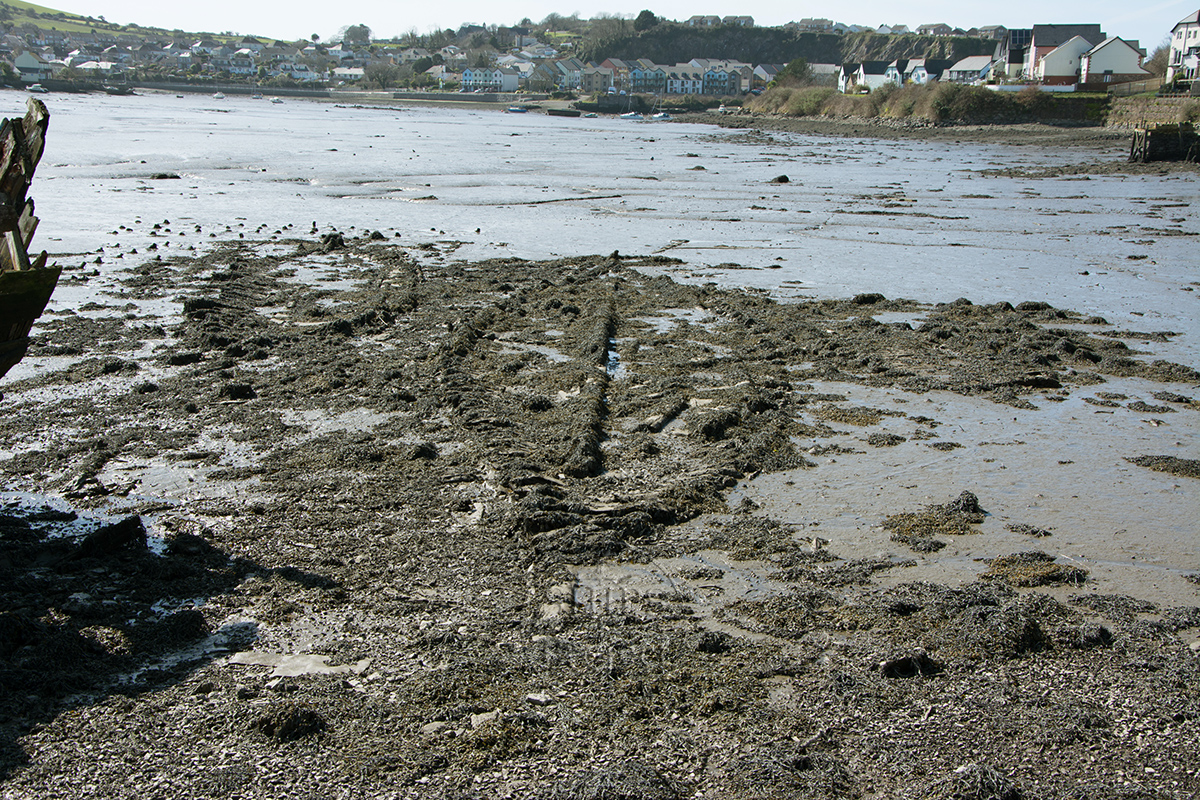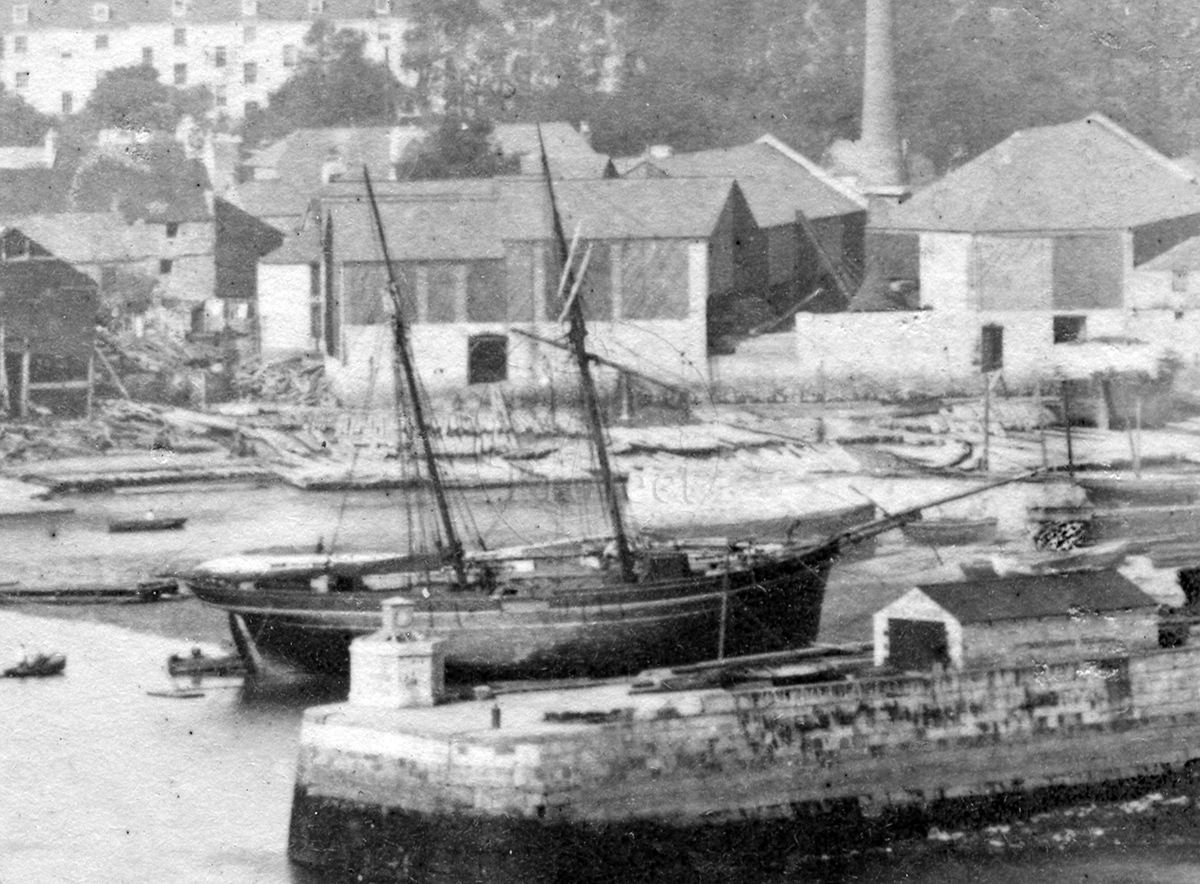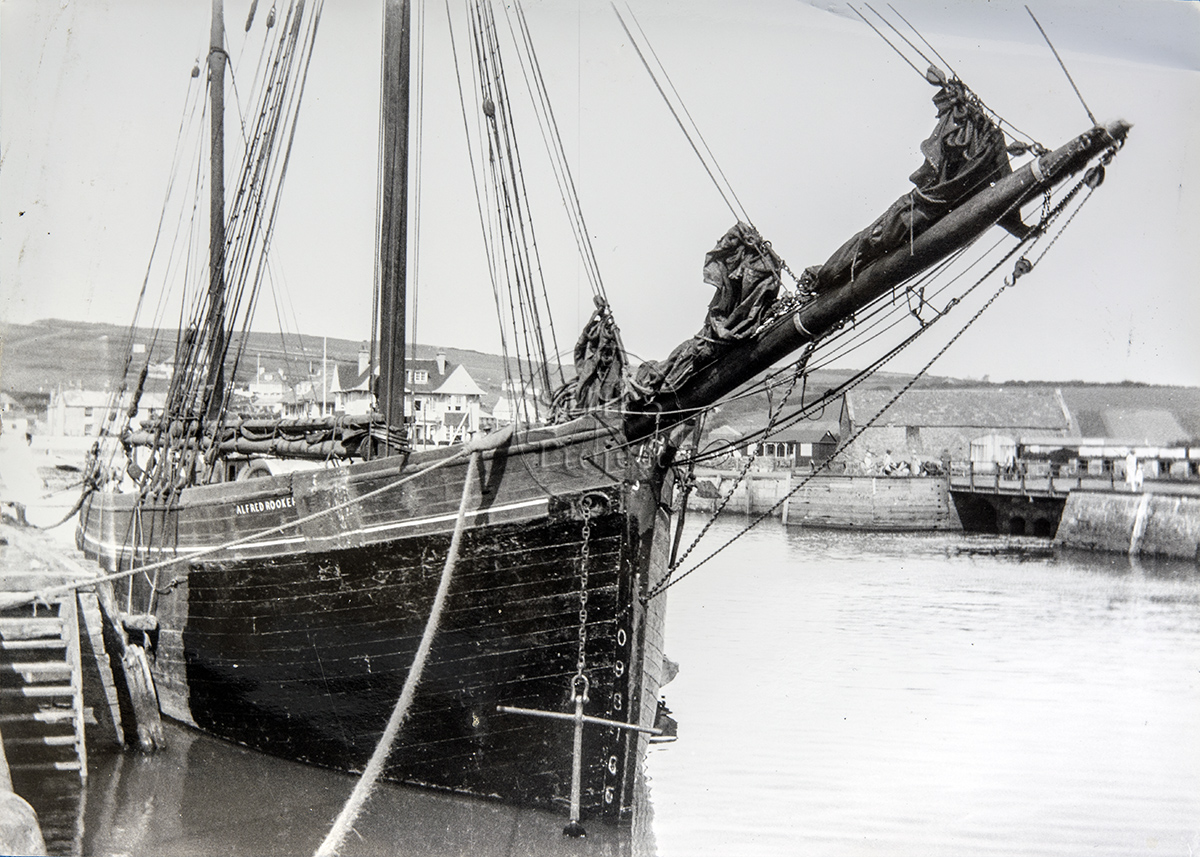Not Set
Introduction
We do not know the names of many of the abandoned ships in Hooe Lake and sometimes the ships turn out to be not the ones that they were thought to be. Often it is because the vessels were abandoned a long time ago and no-one is left who remembers their names. Sometimes it is because only a few people ever knew the name of a vessel and this can happen in the recent past, such as the fishing boat known as Hooe Lake 1 whose name we don't know even though she was abandoned in 1996. Sometimes the names and stories about these hulks get confused so we have to piece together the real story using paper records and the clues in the hulks themselves.
Much of what we know about the hulks in Hooe lake comes from a book called The Lost Ships of the West Country by Langley and Small. This book is a record of all the hulks along the coast and waterways from Dorset to Gloucestershire so its creation was a huge undertaking. The book identifies most of the hulks that were known about in the Plymouth area in the 1980s when it was written. Some hulks are not included and for others the information is incorrect, but this can be excused as the authors had so much ground to cover and at a time when information was much less accessible. What they did have that we do not now is eyewitness stories from local people who remember these ships and boats, and its these stories that seem to cause the most trouble.
The 'Remains of Three Vessels'
Langly and Small describe the 'remains of three vessels' at the east end of Hooe Lake:
"Formerly three hulls moored alongside each other and floating every high tide, they gradually fell into this decay. They are, from left to right: an unidentified craft with both stem and sternpost standing; the Pearl, a Tamar sailing barge once busy in the stone trade and based at Saltash Passage; and the Wendew, a 'mule' class Brixham trawler which came to Plymouth in 1940."
The identification of the trawler Wendew ![]() is correct but she was abandoned in the 1960s, so some time after the other two vessels, so they would not have floated together every high tide as suggested above. The unidentified craft known here as Hooe Lake 4
is correct but she was abandoned in the 1960s, so some time after the other two vessels, so they would not have floated together every high tide as suggested above. The unidentified craft known here as Hooe Lake 4 ![]() was initially thought to be one of the Tamar sailing barges hulked in the Lake, but at 22m long is too large. But the hulk identified by Langley as Pearl is also far too large to be that vessel, this is the 100ft long un-named schooner referred to here as Hooe Lake 3
was initially thought to be one of the Tamar sailing barges hulked in the Lake, but at 22m long is too large. But the hulk identified by Langley as Pearl is also far too large to be that vessel, this is the 100ft long un-named schooner referred to here as Hooe Lake 3 ![]() . Archaeological evidence also suggests that the schooner Hooe Lake 3 was abandoned some time before the Hooe Lake 4.
. Archaeological evidence also suggests that the schooner Hooe Lake 3 was abandoned some time before the Hooe Lake 4.
There is some confusion about the Pearl. In his book Shipping and Trade of the River Tamar, Ian Merry states that the Tamar sailing barge Pearl (ONO 132759) was built in 1840 and was used in the stone trade, 24.3 GRT and 50 tons burthen, described as:
"Sloop, one mast, running bowsprit [a typical Tamar barge]. In 1885 William Lucock was her master. Her joint owners in 1884 were William Stibbs, master mariner, and Sarah Stibbs, widow. In 1914 the Pearl was bought by Jefford & Son, and re-registered as No. 9 of 1914, in the names of five members of that family. She then ran in the St Germans river stone trade. In 1942, just past her century, she was fitted with an engine."
However, records in Plymouth's Other Fleet say that the cutter Pearl (ONO 132759) was built in 1896 by Frederick Hawke of Stonehouse, she was 15.9m / 52ft long with a 4.9m / 16ft beam and a depth in hold of 1.75m / 5.75ft, registered in 1914 at 24.3 tons. This references the builder's account stating that Pearl was built in 1896 at Stonehouse, not in 1840 as Merry describes. The last reference was to her engine being fitted in June 1942, a Bergius Engine Company petrol/paraffin engine of 13BHP, and there is no record of when she was taken out of service.
Ian Merry noted that one of the hulks in Hooe Lake had been identified as the Tamar barge Annie. The Annie (ONO 10857) was built in 1899 by Frederick Hawke of Stonehouse. Merry says she is 35.7ft long but this is a typo as her correct length is 17m / 55.7ft, she has a 5.2m / 17.2ft beam and a depth of hold of 1.9m / 6.2 ft. The Certificate of Registry was cancelled and registry closed in August 1948 as the vessel was delelict and no longer capable of navigation. The Annie was working in Topsham in 1936 and it is not known how (or if) she made her way to Plymouth to be hulked in Hooe Lake.
Merry only reported that the Annie had been identified and he gives no details about how this was done, who did the identification and on what information.
The North Shore Hulks
Langley and Small in their book Lost Ships of the West Country note that three vessels were abandoned on the north shore of Hooe Lake; the schooner Dolphin ![]() , the Tamar barge Bertie
, the Tamar barge Bertie ![]() and an unidentified steamship. The steamship has been tentatively identified as the steam tug Alice
and an unidentified steamship. The steamship has been tentatively identified as the steam tug Alice ![]() .
.
Ian Merry noted in The Westcotts and their Times in 1977 that the Tamar barge Bertie had been abandoned in Hooe Lake. The Tamar barge Bertie, ONO 86511, was built in 1883 by David Banks at Queen Anne’s Battery in Sutton Harbour. The small Tamar sailing barge was just 14.1m / 46.2ft long with a 4.3m / 14.1ft beam and a draught of only 1.4m / 4.7ft, carrying a single mast and a typical Tamar barge smack rig. Just four years after she was built the Bertie was sold on to John Thomas Daymond who lived in Wearde Quay and operated a number of barges. Daymond died in 1919 and his sons sold the Bertie two years later to Thomas Veale of Saltash who then sold her on to FJ Moore. Moore operated numerous quarries in Cattedown and also in Hooe Lake, so it was here that Bertie was finally abandoned and left to rot sometime after her register was closed in 1928. The register says that the Bertie was broken up but this has previously been found not to be true, such as with the barge Edwin ![]() in Pomphlett Lake.
in Pomphlett Lake.
Confusingly, this small Tamar barge called Bertie was abandoned in Hooe Lake just a short distance from the Thames barge called Bertie ![]() . This was noted by Merry so he was aware of the confusion between names and vessels.
. This was noted by Merry so he was aware of the confusion between names and vessels.
The account says that Dolphin was registered as 120 tons, however this Dolphin was registered as only 85 tons in 1870 and this had reduced to just 65 tons when Tope owned her in 1920. It also says that Tope owned her from 1916 with nephew Bill Jackson as mate, but the official records say she was owned by John Carswell at that time.
In the appraisal of the estate of the late Benjamin Sparrow (1778 to 1857), Cattedown limestone merchant, quarry owner and ship owner, was a barge of 18 tons called the Dolphin. With connections to the quarries around Hooe Lake it is possible that this vessel was abandoned here in the same manner as the Bertie above. Another possible candidate is the Dolphin of Plymouth of 59 tons, ONO19346, registered in 1853.
Mystery Ships
Hooe Lake 3
Thought to be the Tamar barge Pearl (see above), but this vessel is far too large and has the wrong shape hull. Schooners of a similar length and date to Hooe Lake 3 would have registered tonnages of between 120 and 140 tons. Langley and Small mention a schooner called the Dolphin of 120 tons, correct for the size of Hooe Lake 3, but the wrong tonnage for the Dolphin built in 1870 mentioned above. Perhaps the names, types and tonnages were mixed up in the tales told about a schooner abandoned in the 1920s to researchers writing about hulks 60 years later.
The lower part of Hooe Lake 3 is all that remains, but what still exists shows that this was a very heavily built vessel. The remains are 31m / 101ft long with a beam of 7.2m, although the original ship would probably be 33m long and have a beam of 8.5m.
A single mast step can be seen 18m aft of the bow but no others remain because they would originally have been cut into the upper keelson and this is missing at each end of the hull. Probably too large for a local trading ketch and the surviving mast step is well forward, this vessel is likely to have originally been a two-masted schooner. The most popular rig for south west vessels of this size was the topsail schooner, with square topsails on the foremast.
Archaeological evidence suggests that Hooe Lake 3 was abandoned before 1921. You can read more about the hulk known as Hooe Lake 3 ![]() here.
here.
Hooe Lake 4
The hulk Hooe Lake 4 has a keel approximately 22m / 72ft long and has a beam of 6m / 19.7ft so is too big to be the Tamar sailing barge Pearl, and is likely to be too big for any Tamar sailing barge. One likely candidate is the ketch Alfred Rooker ![]() , at 21.6m / 71ft long and with a beam of 5.9m / 19.5ft she is the same size as Hooe Lake 4 and she was reported to be in Hooe Lake by Langley and Small but identified as having been broken up in 1935. The Alfted Rooker may have been broken up at the east end of Hooe Lake rather than the west end as previously thought and this also fits with the date for disposal as being no earlier than 1921.
, at 21.6m / 71ft long and with a beam of 5.9m / 19.5ft she is the same size as Hooe Lake 4 and she was reported to be in Hooe Lake by Langley and Small but identified as having been broken up in 1935. The Alfted Rooker may have been broken up at the east end of Hooe Lake rather than the west end as previously thought and this also fits with the date for disposal as being no earlier than 1921.
Archaeological evidence also suggests that the schooner Hooe Lake 3 was abandoned some time before Hooe Lake 4. Hooe Lake 4 / Alfred Rooker was abandoned after Cornubia in 1921 as it sits on top of the steam ferry. You can read more about the hulk known as Hooe Lake 4 ![]() here.
here.
Hooe Lake 1
The motor fishing vessel Hooe Lake 1 ![]() is also a mystery as we do not know her name even though she was abandoned as recently as 1986.
is also a mystery as we do not know her name even though she was abandoned as recently as 1986.
The Steam Ferry Cornubia
One mystery solved. Researcher John Cotton identified that the Millbrook steam passenger ferry Cornubia ![]() had been hulked in Hooe Lake in 1921 and it had been suggested that one of the older hulks at the east end, Hooe Lake 4, was this vessel. But a quick look at Hooe Lake 4 shows this is a heavily built sailing vessel not a lightly built steamship. This mystery was solved by The SHIPS Project in 2020 when we found the remains of the Cornubia buried underneath Hooe Lake 4
had been hulked in Hooe Lake in 1921 and it had been suggested that one of the older hulks at the east end, Hooe Lake 4, was this vessel. But a quick look at Hooe Lake 4 shows this is a heavily built sailing vessel not a lightly built steamship. This mystery was solved by The SHIPS Project in 2020 when we found the remains of the Cornubia buried underneath Hooe Lake 4 ![]() .
.
Nearby hulks include the lighter Arthur ![]() , the fishing boat Hooe Lake 1
, the fishing boat Hooe Lake 1 ![]() , Brixham trawler Wendew
, Brixham trawler Wendew ![]() , unknown vessel Hooe Lake 4
, unknown vessel Hooe Lake 4 ![]() and the Millbrook steam ferry Cornubia
and the Millbrook steam ferry Cornubia ![]()
Last updated 24 May 2021
Margaret Jarvis
My grandfather used to go out at low tide in the 50’s and get wood for his fire, it burnt with a lovely blue flame. Our family home overlooked the lake.
Stone Cargoes
The vessel may have been reinforced to carry heavy stone cargoes:
They were bad cargoes in rough weather and we rarely carried more than 100 tons (in Via, built by Uphams in Brixham, ed.), for a schooner with a kerb cargo sailed as if in a straight-jacket and, in a seaway, she had a most uncomfortable roll, the deadweight at the bottom of her half-filled hold acting like a pendulum. I was always glad when a ‘stone’ cargo had been landed.
Schoonerman, Richard England, p53
Not Set
Leave a message
Your email address will not be published.
Click the images for a larger version
Image use policy
Our images can be used under a CC attribution non-commercial licence (unless stated otherwise).




